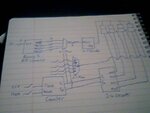Azaxa
Newbie level 4
I am creating a Time-Multiplexed Quad Seven-Segment Display where the last 2 digits of the display, AN2 & AN3, show the decimal value 00-99 from an input of 8 switches (ignoring values at 100+). I have a few examples of code where the output on the display is correct according to ISim but with synthesis errors, another where the synthesis is correct but display values are incorrect. I believe it has something to do with the binary to BCD conversion from analyzing I/O results from all registers in the code (most likely blocking(=)/non-blocking(<=) procedural assignments)
If anyone could lend a hand on this it would be appreciated.
Synthesis works but display is incorrect:
Display is correct but Synthesis doesn't work giving an error
Both using this test bench/text fixture.
P.S. if you can understand why the binary to BCD converter produces the correct BCD value on the display using hexadecimal switch input values when it should be working with decimal instead that would be helpful; using the second program example. Thanks in advance.
S.D.
If anyone could lend a hand on this it would be appreciated.
Synthesis works but display is incorrect:
Code Verilog - [expand]
Display is correct but Synthesis doesn't work giving an error
ERROR:Xst:880 - "example.v" line 102: Cannot mix blocking and non blocking assignments on signal <shift>.
ERROR:Xst:880 - "example.v" line 98: Cannot mix blocking and non blocking assignments on signal <shift>.
Code Verilog - [expand]
Both using this test bench/text fixture.
Code Verilog - [expand]
P.S. if you can understand why the binary to BCD converter produces the correct BCD value on the display using hexadecimal switch input values when it should be working with decimal instead that would be helpful; using the second program example. Thanks in advance.
S.D.
